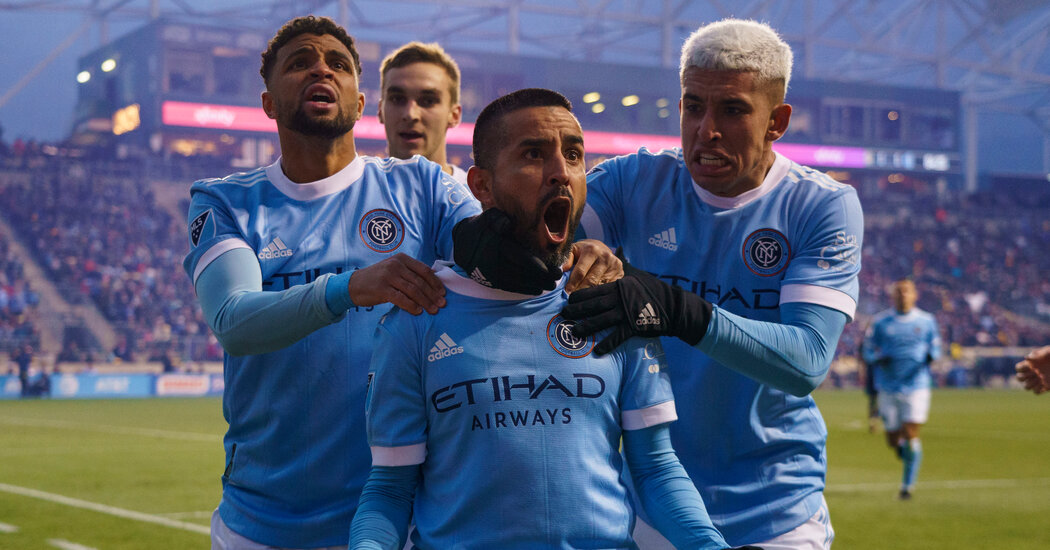
PORTLAND, Ore. — The road, New York City Football Club executives said as far back as 2015, was always supposed to lead here, to big moments, to finals, to trophies. That, they said, was always the plan.
Those who haven’t paid close attention to New York City F.C.’s roster evolution the past few years might not have seen the plan quite so clearly, and so they might be surprised to scan the Manchester City-backed team’s roster ahead of the M.L.S. Cup final on Saturday against the Portland Timbers. There are no longer any Andrea Pirlos, no Frank Lampards, no David Villas in N.Y.C.F.C.’s squad — the kind of boldfaced European imports that once gave the team a flash of star power in its early years of existence.
Instead, the team’s run to its first berth in Major League Soccer’s championship game this year has been led by two comparatively unheralded Argentine players: Maxi Moralez, a 34-year-old midfielder who once won a youth World Cup alongside brighter lights like Sergio Agüero and Ángel Di María, and forward Valentín Castellanos, the leading scorer in M.L.S. this season. They, and a supporting cast of teammates with plenty of talent but little name recognition, have delivered N.Y.C.F.C. to the brink of its first title.
The shift in roster strategy since the team’s inaugural season in 2015 — an overhaul that parallels the league’s own recent transformation toward developing young talents instead of importing established stars — was not the result of sudden enlightenment, however.
It was, a top team executive said on Friday, the plan all along.
“We are here for the long term,” said Ferran Soriano, the chief executive of City Football Group, whose growing network of soccer clubs around the world includes not only Manchester City of the Premier League and N.Y.C.F.C. but also nine other teams in 11 countries. “And the long term is not five years. It’s not 10. It’s 50.”
That this year’s version of N.Y.C.F.C. reached the final, then, represents less a long-awaited breakthrough for the team’s ownership group and more of an expected step on a long, well-plotted path.
“Being at this club for five years and understanding the standards this club has, to put ourselves in position to win M.L.S. Cup means everything,” goalkeeper Sean Johnson said.
Said Soriano: “We’re very happy to be in the final — very happy. It’s a symbol to what we have achieved. But in reality, the work has been steady year after year.”
That was not always apparent in the results. Despite making the playoffs in five of its first six seasons, N.Y.C.F.C. won only a single playoff round in those trips. It has won more postseason matches in 2021 (three) than in its first six seasons combined (two).
Soriano acknowledged that the early N.Y.C.F.C. teams were hampered on the field by their top-heavy constructions, which saw cheaper players fill out the rosters alongside multimillion-dollar stars like Villa, Lampard and Pirlo. That led to regular disappointments, as regular-season successes were frequently followed by quick postseason exits.
Soon, though, team executives worked within M.L.S.’s thicket of roster and salary rules to make smart signings like Moralez and to bring City Football Group’s resources to bear in more positive, more productive ways.
The 23-year-old Castellanos, for example, joined as a teenager in 2018 on loan from the Uruguayan club Torque, which is also owned by City Football Group, and later signed a permanent deal to stay in New York. For Castellanos, the move represented a step up the C.F.G. ladder — an actual ranking of leagues that the group created using data and analytics. (The Premier League is at the top, Soriano said, with M.L.S. somewhere in the middle, “a bit higher than Japan.”)
The system of linked clubs is not without conflict. Castellanos’s manager at Torque resisted the transfer, Soriano said, and the Uruguayan team struggled after his departure — a fate that could come to N.Y.C.F.C., too, if and when ownership decides it is time for their newest star to move on.
But the system also requires patience from a fan base that has not always understood the need for popular, and vital, players like Jack Harrison, now at Leeds United; Yangel Herrera, who left New York for La Liga in Spain; and others to move on to a higher level of development than M.L.S.
“This is a long game for the City Football Group,” M.L.S. Commissioner Don Garber said. “They’re thinking about their investment in Major League Soccer over a generational time frame.”
At the beginning, that meant spending for star power that might attract attention to the newest City-owned club. But it also meant investments in an academy that helped groom stars like Gio Reyna and Joe Scally, and in the belief that a constant churn of talents will yield a more talented roster year after year.
“The way we measure the work that we do every day is what we do in the regular season,” Soriano said. “That’s a good measure of what we do. Then we go to the playoffs and maybe you can be lucky. But if you go to the playoffs regularly, one day you will win.”



